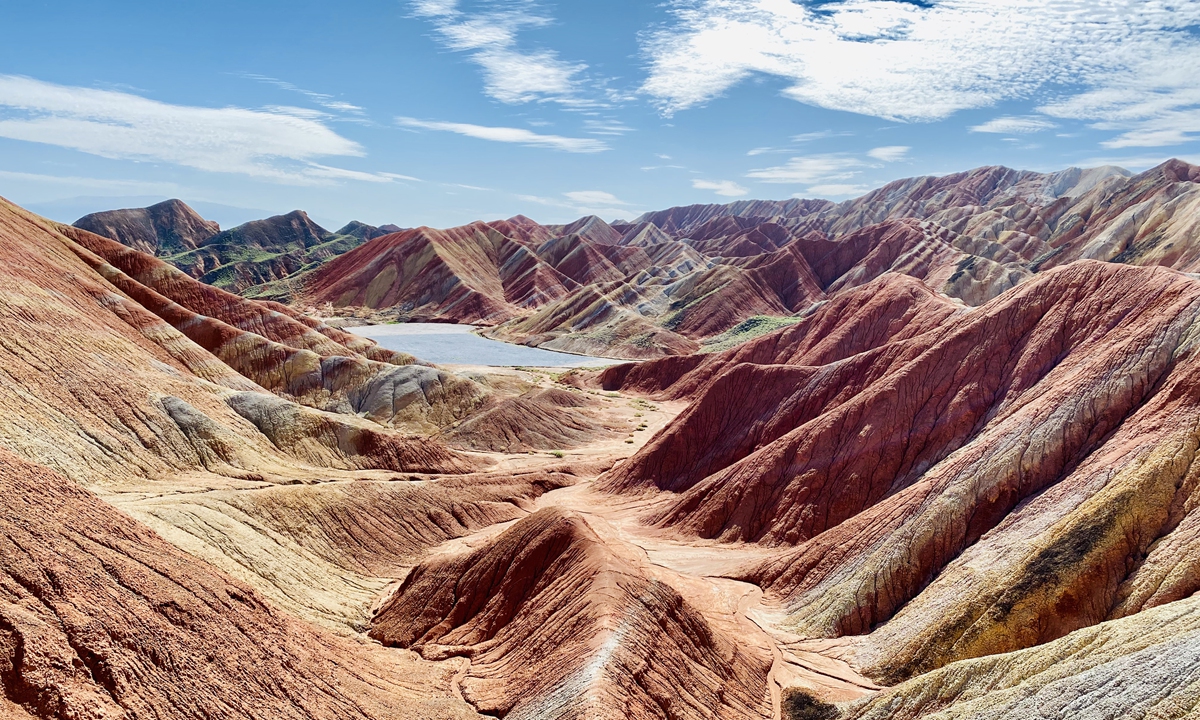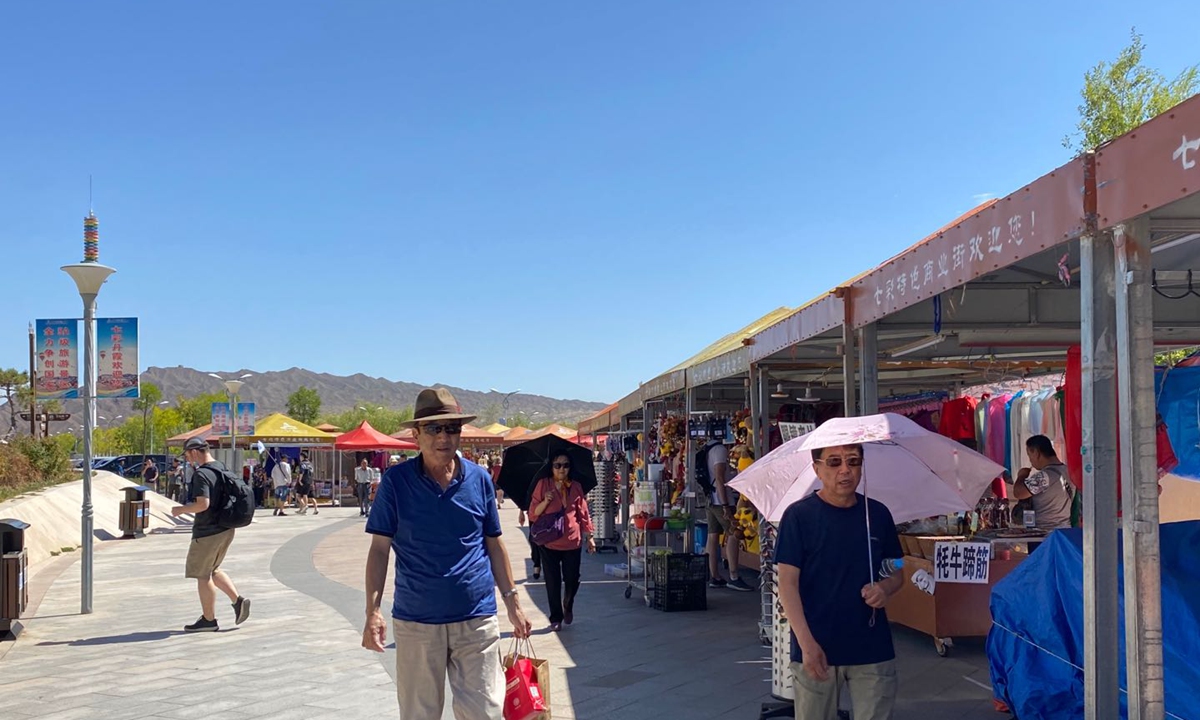China's tourism industry waits for boom, pent-up demand in October
China’s tourism industry waits for boom, pent-up demand in October

Boasted as a national 5A tourist attraction, Zhangye Danxia National Geological Park in Northwest China's Gansu Province provides tourists with views precipitous red cliffs and rainbow ridges. Photo: Zhang Dan/GT
From the beaches of the "Hawaii of China" Sanya, to the Mogao Grottoes in Dunhuang, the comeback of Chinese tourists to domestic scenic spots rekindled hope for the heavily-hit tourism industry following the COVID-19 pandemic.
Chinese travelers are sticking to domestic excursions as international travel is still heavily restricted. Industry practitioners and analysts are anticipating a nearly 90 percent year-on-year recovery in the overlapping Mid-Autumn Festival and the National Day holiday in October, with pent-up consumption demand to be unleashed.
Return of tourists

Tourists pass by the souvenir shops at the Zhangye Danxia National Geological Park in Northwest China's Gansu Province on September 3. Photo: Zhang Dan/GT
"Could you help me take a photo here please?"
Tour guides at Zhangye Danxia National Geological Park in Northwest China's Gansu Province again heard the familiar question.
Although the park reopened as early as March, few tourists came to visit due to fears around COVID-19, but they are now coming back.
Sitting in the eastern foothills of the Qilian Mountains in Zhangye, Gansu, the spectacular Danxia landform provides tourists with views precipitous red cliffs and rainbow ridges.
"I feel safe when travelling in our country as we have contained COVID-19," a tourist from Central China's Henan Province who took her family to travel in Gansu told the Global Times at the park.
According to Zhanye's tourism bureau, more than 15.09 million trips were made to the city in the first seven months of this year, generating revenues of 9.6 billion yuan ($1.4 billion).
"We saw a clear increase in summer. So far, the number of tourists visiting Zhangye has recovered more than 70 percent when compared with previous years, as the virus, certainly, influenced people's travel," the bureau chief Xu Wanfu told the Global Times.
In order to attract tourists, the city is now launching a variety of campaigns, such as giving discounts on landmark tickets, providing additional sales to local people and advertising on social media and short video platforms.
Xu added that the culture and tourism-oriented service sector accounts for more than 55 percent of the city's economy. "Recovered tourism drove up the quick rise of the service sector, promote job employment and consumption revival."
China's Ministry of Culture and Tourism announced in mid-July that travel agencies would be allowed to offer trans-provincial trips. Such measures boosted China's tourism sector as the summer vacation for students (July and August) is usually the high season.
According to China's biggest online travel agency Trip.com Group, single-day air passenger volume at the end of August has nearly recovered to the same level as last year. Overall, passenger volumes over the summer vacation have recovered 80 percent when compared with last year.
Surprisingly, Sanya Phoenix International Airport in South China's Hainan saw a better performance in August year-on-year, facilitating 3 million trips, Trip.com Group told the Global Times on Friday. Outstanding performance airports this summer are mainly touristy cities: Chengdu, Shenzhen, Chongqing, Sanya, Lhasa, Lijiang, Dali and Xining.
Golden Rebound
The pre-bookings of package tours, self-guided tours and car rental services for the National Day holiday have already soared in recent days, Trip.com Group told the Global Times.
"I haven't seen crazy new orders coming in like this for a long time," the owner of a travel agency cooperating with Trip.com said.
The National Day Holiday together with the Mid-Autumn Moon Festival at the beginning of October will give the Chinese people an eight-day break, highly likely to stimulate a further rebound of the domestic tourism sector.
"Because cross-border tourism has not yet reopened, outbound travel is heavily restricted, leaving some Chinese travelers shifting focus to the domestic tourism market, which may see a concentrated boom during the eight-day holiday," Ji Zhiying, a travel industry analyst at Beijing-based consulting and research firm Analysys, told the Global Times.
However, Ji estimated that tourist volumes will not surpass that of last year, and around 90 percent recovery could be foreseen with tourism revenue regaining 80-90 percent.
At present, some groups, such as students and teachers, have to follow local rules to duce unnecessary trips in order to comply with coronavirus prevention and control measures, and it is not certain whether these requirements will still apply during the holiday, with students accounting for a large number of tourists during the National Day holiday, according to Ji.
Last year, there were 782 million domestic tourist trips during the National Day holiday, with revenues of 649.71 billion yuan which accounted for about 9.8 percent of the total annual tourism-related revenue.
Contrasted with domestic rebound, shopping malls in Europe still remained relatively empty compared with previous years due to a lack of Chinese tourists.
Over the decade, China has become the world's largest source of outbound tourists. Last year, Chinese people made about 155 million outbound trips, up 3.3 percent year-on-year.
Judy, who has been engaged in tourism in Hungary for 16 years, told the Global Times in a previous interview that the number of Chinese tourists to Central and Eastern Europe may not return to pre-pandemic levels in the next two years, even after the pandemic is over. "Chinese people may be cautious after seeing how some European governments have handled COVID-19."
The consequences of the pandemic on tourist confidence may last for a while and the outbound travel may be heavily impacted, warned industry analysts.
Ji said that global tourism industry recovery has many uncertainties. "It took more than half a year for China to see such rebound while COVID-19 is still spreading abroad."


